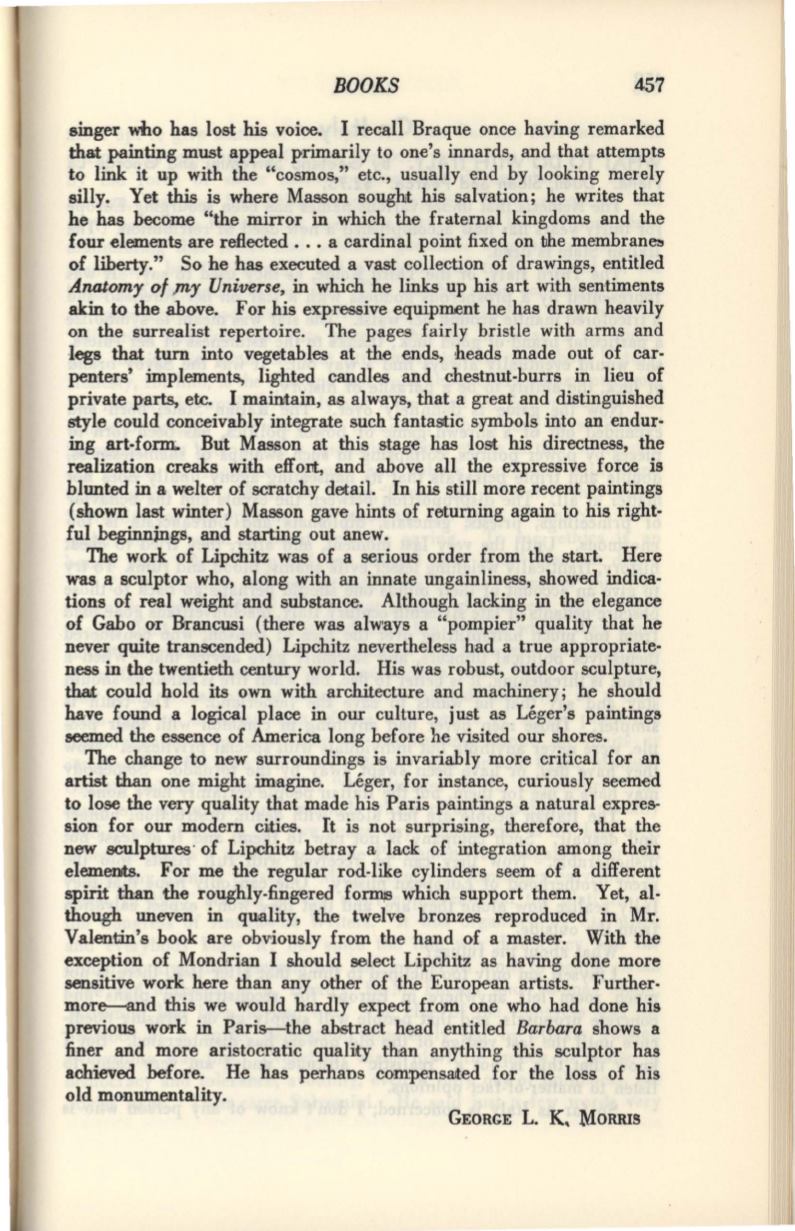
BOOKS
457
singer who has lost
his
voice. I recall Braque once having remarked
that
painting must appeal primarily to one's innards, and that attempts
to link it up with the "cosmos," etc., usually end by looking merely
silly. Yet
this
is where Masson sought his salvation; he writes that
he has become "the mirror in which the fraternal kingdoms and the
four elements are reflected ... a cardinal point fixed on the membrane:.
of liberty." So he has executed a vast collection of drawings, entitled
Anatomy of JnY Universe,
in which he links up his art with sentiments
akin to the above. For his expressive equipment he has drawn heavily
on the surrealist repertoire. The pages fairly bristle with arms and
legs that turn into vegetables at the ends, heads made out of car–
penters' implements, lighted candles and chestnut-burrs in lieu of
private parts, etc. I maintain, as always, that a great and distinguished
style could conceivably integrate such fantastic symbols into an endur–
ing art-form. But Masson at this stage has lost his directness, the
realization creaks with effont, and above all the expressive force is
blunted in a welter of scratchy detail. In
his
still more recent paintings
(shown last winter) Masson gave hints of returning again to his right–
ful beginnjngs, and starting out anew.
The work of Lipchitz was of a serious order from the start. Here
was
a sculptor who, along with an innate ungainliness, showed indica–
tions of real weight and substance. Although lacking in the elegance
of Gabo or Brancusi (there was always a "pompier" quality that he
never quite transcended) Lipchitz nevertheless had a true appropriate–
ness in the twentieth century world. His was robust, outdoor sculpture,
that
could hold its own with architecture and machinery; he should
have found a logical place in our culture, just as Leger's paintings
seemed the essence of America long before he visited our shores.
The change to new surroundings is invariably more critical for an
artist
than
one might imagine. Leger, for instance, curiously seemed
to lose the very quality that made his Paris paintings a natural expres–
sion for our modern cities. It is not surprising, therefore, that the
new sculptures· of Lipchitz betray a lack of integration among their
elements. For me the regular rod-like cylinders seem of a different
spirit
than
the roughly-fingered foriJliS which support them. Yet, al–
though uneven in quality, the twelve bronzes reproduced in Mr.
Valentin's book are obviously from the hand of a master. With the
exception of Mondrian I should select Lipchitz as having done more
sensitive work here than any other of the European artists. Further–
more----and this we would hardly expect from one who had done his
previous work in Paris-the abstract head entitled
Barbara
shows a
finer and more aristocratic quality than anything this sculptor has
achieved before. He has perhans compensated for the loss of his
old monumentality.
GEoRGE
L. K,
MoRRis


